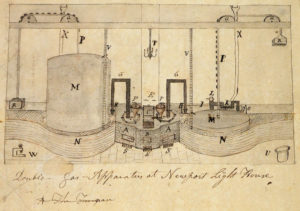During much of December in Newport, sunset is stuck at 4:16 P.M. and people are scrambling to accomplish outdoor tasks before the street lights come on. Street illumination with candles and smudge pots can be traced back centuries, but gas lighting in America can be credited to David Melville (1773-1856) of Newport. A pewterer by trade and manufacturer of housewares, Melville experimented with hydrogenous gas, made from burning coal and wood. In 1805 he illuminated his house and sidewalk on the corner of Thames and Pelham Streets with gas. By 1810 he had secured a U.S. Patent. With partnerships in Boston and Providence, Melville tried to promote his invention but costs were too prohibitive. He even tried to light the Beavertail Light House with gas in 1817, but lobbying from whale oil interests in Nantucket and New Bedford killed the proposal after one year, despite support from William Ellery and other congressmen. Discouraged, Melville returned to metalwork, but lived long enough to see the creation of the Newport Gas Light Company in 1853.

Diagram of “Double gas apparatus at Newport Light House” from David Melville’s 1817-1818 Meteorological Diary. Vol 96, NHS.
